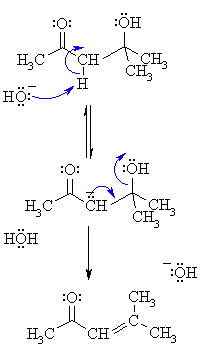| Chapter 18: Enols and Enolates |
| Chapter 18: Enols and Enolates |

Summary
| Study Tip: Try to recognise the two units that came together and identify the nucleophilic (enolate) portion and the electrophilic (carbonyl) portion. Recognise the enone that arises from dehydration. |
Related Reactions
MECHANISM OF THE ALDOL CONDENSATION OF A KETONE
|
|
1. MECHANISM OF THE ALDOL
REACTION OF A KETONE
|
|
| Step 1: First, an acid-base reaction. Hydroxide functions as a base and removes the acidic α-hydrogen giving the reactive enolate. |
 |
| Step 2: The nucleophilic enolate attacks the ketone at the electrophilic carbonyl C in a nucleophilic addition type process giving an intermediate alkoxide. |
|
| Step 3: An acid-base reaction. The alkoxide deprotonates a water molecule creating hydroxide and the β-hydroxyketone, the aldol product. |
|
2. MECHANISM OF THE DEHYDRATION
OF THE ALDOL PRODUCT
|
|
| Step 1: |
 |
| Step 2: The electrons associated with the negative charge of the enolate are used to form the C=C and displace the leaving group, regenerating hydroxide giving the conjugated ketone. |
|
| © Dr. Ian Hunt, Department of Chemistry |